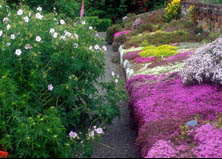Monday, 11 December 2006
Monday, 4 December 2006
Gardens of Northumberland and the Borders
 My sixth gardening book has just been published and Simon Fraser and I have been busy this week with book signings in local bookshops - one is planned for Sunday 10th at the National Trust garden, Wallington. There have been two full page spreads about it in the Journal and the Hexham Courant (see their website), liberally illustrated with some of Simon's pictures. I spent a year researching the book, seeing the gardens throughout the seasons to get a full understanding of each of them, and it is very exciting to see the finished product. This has been the twentieth anniversary of my garden and it has been a very busy time, so I sometimes wonder how it all got fitted in.
My sixth gardening book has just been published and Simon Fraser and I have been busy this week with book signings in local bookshops - one is planned for Sunday 10th at the National Trust garden, Wallington. There have been two full page spreads about it in the Journal and the Hexham Courant (see their website), liberally illustrated with some of Simon's pictures. I spent a year researching the book, seeing the gardens throughout the seasons to get a full understanding of each of them, and it is very exciting to see the finished product. This has been the twentieth anniversary of my garden and it has been a very busy time, so I sometimes wonder how it all got fitted in.
Posted by
Susie White
at
17:38
6
comments
![]()
Labels: books
A windy week in early December
Hearing the high winds in the night, I felt anxious about how the garden was faring - so it was with a little trepidation that I turned the heavy, old-fashioned key in the door to the walled garden. The gales were still battering the tall beech trees around the garden, but there was a calmer atmosphere within the sheltering walls. I walked round to check everything and, apart from some fleece detaching itself and getting snagged in a rose bush, there was no damage to the plants. Having had a mature laburnum tree knocked down last year, I was relieved there were no problems now; over the twenty years I have been running the garden, I have definitely noticed the worsening winds in the last few years, which I personally connect with global warming. The fleece had been protecting a fig tree - another sign that things are changing, as I would not have been able to grow this outside in Northumberland, with or without fleece, in past years.
Mistle thrushes have been making a racket with their throaty, rattling cries as they pick luscious red berries out of the yew trees. It has been a fantastic autumn for fruits of all kinds, the espalier apple trees laden, rose hips making vibrant arching shapes and hazel nuts in the hedgerows providing plenty for the red squirrels. There have always been reds in the woods at Chesters and we sometimes even see them in the garden - one autumn day, a red squirrel curled up on the lawn to sleep in the weakening sunshine. My son, Thomas, is doing the Foundation Degree course in Photography at Newcastle College and wanting to specialise in wildlife photography and this is his photograph, taken this week, of a red squirrel.
Posted by
Susie White
at
16:46
1 comments
![]()


